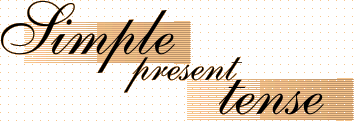Bueno ya vimos presente simple con el verbo to be. Ahora veamoslo con los action verbs
Action verbs are all the verbs that are not to be verbs, (verbos que no son ser o estar) for instance: play, run, go, study, work ... etc
Positve sentences:
Each verb has 2 conjugations in the simple present: one without to and one adding "s".
Examples:
to play -------- play / plays
to study ------ study / studies
to wrtie------- write / writes
to go ---------go / goes
Now which pronouns go with the "s" form?
Remember the to be form? Which goes with is? YES! he she it.
So => he, she, it go with the "s" form and I, you, we, they with the simple form.
Examples:
Miguel watches tv everyday => He watches
My parents live in Lima => They live
I like dancing
You can make any positive sentence now. Suppose you want to say : " Mi mama quiere pizza"
Go to the dictionary what is "querer" en ingles => to want
Entonces:
My mother wants pizza => why wants? because my mother = she.
Notas del profesor:
Como ven las conjugaciones de los verbos son solo 2 : Una con "s" y la otra sin "s". Esto debería ser mas fácil pues en español tenemos :
Verbo Jugar
Yo - Juego
Tu - juegas
ellos ellas ustedes - juegan
vosotros/vosotras- jugáis
Recuerden de ponerle la "s" cuando corresponda a la tercera persona singular.
My mother cooks everyday | My father works at night | My sister always studies
He / she / it + doesn't + infinitive (work)
Examples:
+ Maria plays tennis every morning
- Maria doesn't play tennis
+ Juan works for a very important company.
- Juan doesn't work.
+ My parents live in France
- My parents (they) don't live in France.
+ I like to study English.
- I don't like to study English
NOTE:
REMEMBER: We do NOT use don't and doesn't with THE TO BE VERB
+ Patty is my sister
- She ISN'T my sister.
Notas del profesor:
Como ven las conjugaciones de los verbos en negativo son solo 2 :
EL don't y el doesn't son auxiliares. Es decir, ayudan a los verbos (QUE NO SEAN TO BE).
Por ejemplo.
+ My father works for IBM.
- My father doesn't work for IBM
>>> Vemos que cuando se usa el doesn't ya no se le pone la "s" a el verbo (work). Esto es porque esta el auxiliar y le ayuda. En otras palabras, cuando pongan el negativo a verbos en presente simple que no sean to be, el que se conjuga son los verbos auxiliares (don't and doesn't) y no el verbo en si.
Question structure
DO + I / you / they / we
Ejemplos:
(+) Maria cooks in the afternoons
(-) Maria doesn't cook in the afternoons
(?) When does Maria cook?
os:
(+) Juan has lunch at 12:30.
(-) Juan doesn't have lunch at 12:30.
(?) Does Juan have lunch at 12:30?
(+) You play soccer very well.
(-) You don't play soccer very well.
(?) Do you play play soccer very well?
(+) My friends like dancing.
(-) They don't like dancing
(?) Do they like dancing?
CONCLUSIONES
¿Cuando uso do and does?
- Se usa do en does en preguntas y en negativos (don't / doesn't) en el present simple siempre y cuando no sean verbos to be.
¿Cuando pongo la "s" en los verbos?
- Se le agrega la "s" cuando formen verbos en positivo en el present simple con verbos que no sean to be y que el sujeto sea la 3ra persona singular (HE, SHE, IT)
¿Que no sea to be? ¿A que te refieres?
- El verbo to be es ser o estar. Cuando utilizes estos 2 verbos en el present simple no se utiliza los auxiliares do y does. El verbo to be es mas simple pues solo se le agrega el NOT para negativo y para preguntas se invierte el verbo con el sujeto:
She is pretty ----- She is NOT pretty -------- Is she pretty?
Los verbos que no son to be pues son todos aquellos que no son ser y estar (work, smoke, play, sleep.... ETC ETC)
Ver clase del present simple con el verbo to be
¿Cuando utilizo el present simple?
- Para describir rutinas, hábito, hechos (water boils at 100 degress celcious - el agua hierve a 100), y cosas permanentes. El present simple no se utiliza para describir cosas que pasan en el momento.
Ver clase del USO de Simple Present












